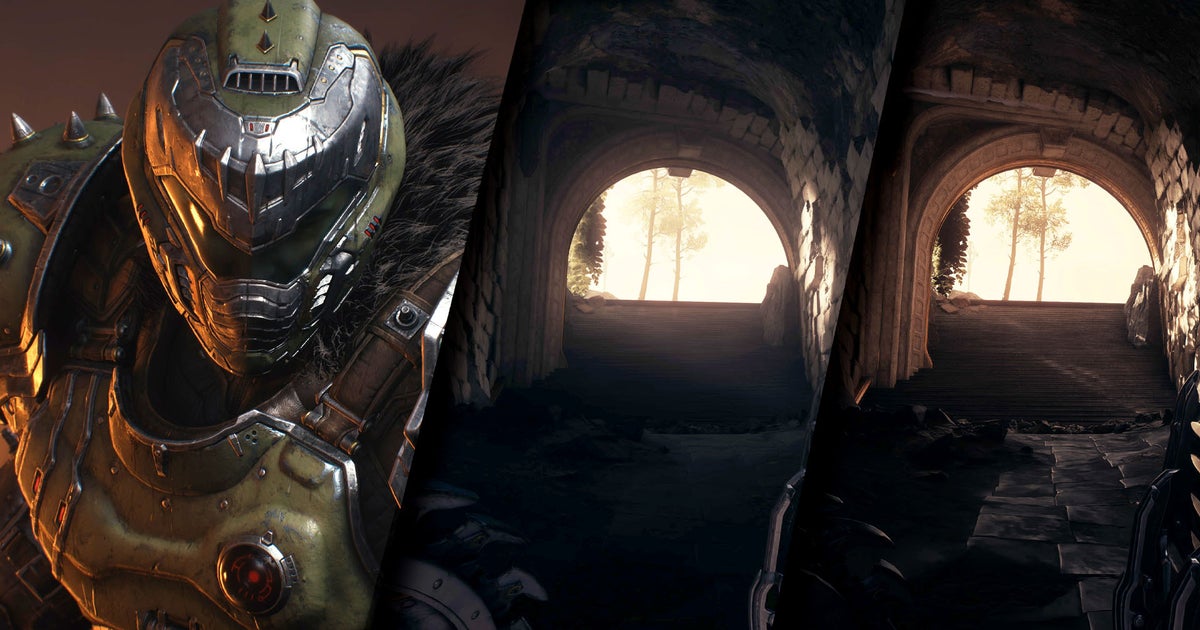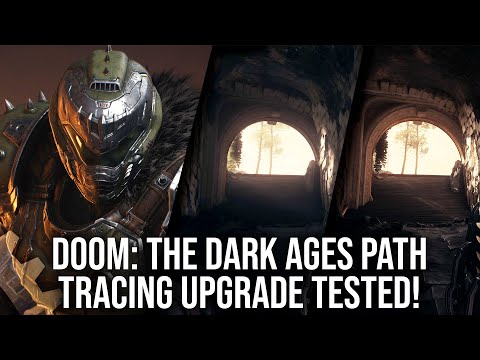Doom: The Dark Ages has finally received its promised path tracing upgrade on PC, adding a further dimension of visual fidelity to an already impressive game. To see how the new graphics mode compares to the standard RT available at launch, some testing was in order.
I ran the game on a high-end desktop PC with an RTX 5090 graphics in the new path tracing mode, while my colleague John tested the game on a laptop RTX 5090 with standard RT graphics. It made for a fascinating comparison, with some areas exhibiting just how good the standard RT graphics already were, while other scenes showed off the kind of uniquely realistic visuals that only path tracing can provide.
We opted for the second mission in the game, Hebeth, as it includes plenty of Doombase-style shiny surfaces and therefore ought to be a good showcase for the new graphics techniques in play.
One of the first thing we noticed is that the cutscenes show relatively few changes in side-by-side comparisons. That’s because the cutscenes are authored with plenty of extra light sources placed just where they’re needed to light subjects with the cinematography in mind, in comparison to gameplay which needs to look correct no matter what the player is doing. Given that the game already featured ray-traced global illumination (RTGI), that means these controlled scenes tend to look fairly similar between a PC running with standard RT and path tracing.
Once in gameplay, the stone floors near the start of the level provide our first out-and-out difference versus the standard RT presentation. With path tracing enabled, these rougher surfaces provide reflections, with bright nearby objects clearly visible, even when off-screen. By contrast, the standard RT look has a more conservative roughness cut-off, with only shiny surfaces sporting reflections. This even extends to your weapons, with the shotgun and other armaments reflecting bright light sources in the path tracing mode.
Interestingly, these reflections are often more mirror-like and coherent in the standard RT mode to save performance, whereas the path tracing has a duller but more realistic (and expensive) look.
The path tracing BVH also includes elements that are dropped in the standard RT mode when they don’t appear on-screen, most notably force-fields and holograms, but there’s plenty of other particles, leaves and transparencies too. Objects in the reflection also sport more complex materials, which is quite evident in the glossier environments found in the interiors of this level.
Of course, the path tracing mode isn’t just about reflections – it also uses a higher number of bounces for its global illumination. This can make some scenes noticeably lighter, eg allowing light to bounce multiple times to reach an interior space from the sun and sky outside.
The path tracing mode also suffers from fewer incidents of light leaking through solid walls to illuminate areas it shouldn’t, thanks to its more fine-grained per-pixel light calculations. Having the better denoiser of ray reconstruction enabled in the path tracing mode also gets rid of the stippled look of volumetric lighting in the standard RT mode.
Emissives are another area where the path tracing mode looks significantly more realistic. Light sources in your environment, such as fires, gun tracers and even LED light strips, actually produce light that shines on its surroundings with path tracing enabled, something that’s disabled in the standard RT mode.
There are relatively few differences in terms of shadows, with most scenes taking place indoors and already featuring quite sharp shadows. Instead, you’ll see more noticable changes outdoors, where long distance shadows are sometimes presented more clearly in the path tracing mode that are incredibly soft and diffuse in the standard RT mode, due to how coarse the calculations are to save performance. There’s less shadow break-up in outdoor scenes too.
Speaking of performance, the full path tracing mode is light – at least in relative terms. We saw around a 39 percent drop in frame-rate with path tracing engaged versus standard RT in our test scene, using a high-end PC with an Nvidia GeForce RTX 5090 graphics card and AMD Ryzen 7 9800X3D using 4K DLSS Performance and ultra nightmare settings.
That’s a significant drop, but still a smaller margin than we’ve seen in other games, like Cyberpunk 2077. It speaks to both how much RT is provided in the base game – and how well architected id’s latest release is, as we’ve come to expect from the studio.
Going through this footage, one thing that struck me is just how scalable Doom: The Dark Ages is. The game still looks pretty reasonable even on “low” settings or on more limited consoles like the Xbox Series S, but there’s a huge assortment of visual niceties that you can add on if you have the performance to spare.
This new path tracing mode is the logical conclusion, bringing unparalled realism to the game’s fantastical environments for those on higher-end PCs – and earning major plaudits for id’s top-tier developers.

